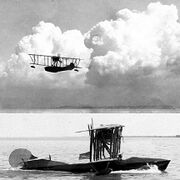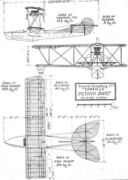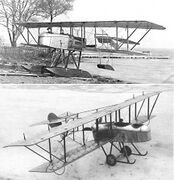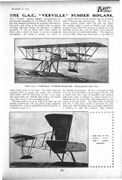General Aeroplane Company
Topic: Company
 From HandWiki - Reading time: 3 min
From HandWiki - Reading time: 3 min
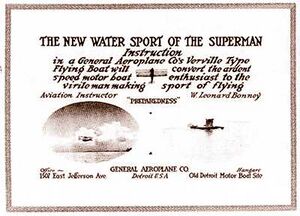 | |
| Type | Private |
|---|---|
| Fate | Dissolved |
| Founded | Detroit, U.S. (February 10, 1915) |
| Founder | Corwin Van Husen Fred and Russell Alger |
| Defunct | August 28, 1918 |
| Headquarters | Detroit, Michigan , |
Key people | Alfred V. Verville, Herbert B. and Frank P. Book, Wm. Hendrie, Jerome H. Remick |
The General Aeroplane Company was Detroit's first commercial airplane builder.[1] GAC built three types of aircraft during the First World War and operated a flying school. The aircraft were the Verville Flying Boat, the Gamma S biplane with floats (floatplane), and the Gamma L biplane with wheels. All had engine installations driving pusher propellers.[2]
Founding
The key player in the company was 18-year-old Corwin Van Husen, who was supported by his guardian W. Howie Muir and other key players of Detroit and Grosse Pointe society. Other major investors included Fred and Russell Alger (who were also investors in the Wright Company and had demonstrated the Wright craft at the Grosse Pointe Country Club four years earlier), Herbert B. and Frank P. Book, Wm. Hendrie, and Jerome H. Remick.[3]
In November 1915, the GAC hired 24-year-old Alfred V. Verville, an experienced airplane designer who would be a part of Detroit's aviation activities for years to come. Design of the company's first airplane, a two-passenger biplane flying boat, was completed in December and construction of the hull was begun by the Mayea Boat & Aeroplane Works.
The flying boat was flight tested during early 1916 and was advertised nationally for sale beginning in September. The U.S. Navy purchased the plane as a trainer, the first built-in-Detroit airplane sold for profit.[4][5]
With U.S. involvement in World War One imminent, Verville began designing a military airplane, the Gamma. By November 1916, the prototype, a "pusher" type plane with the engine and propeller behind the crew, was fitted with seaplane floats and test flown from its base on the Detroit River. In the meantime, the leading industry magazine Aviation gave the GAC plane a boost by running a two-page story about the as yet unproved craft.[6] For the winter the Gamma was fitted with wheels to replace the floats. On its maiden flight from frozen Lake St. Clair, a wind blew the Gamma into a snow bank, and it crashed. The pilot, William Bonney was unhurt, but the Gamma was destroyed.[5]
Dissolution
On August 28, 1918, GAC ceased operations.[1]
Aircraft
- Verville flying boat (aka Beta), 1916
- 2 passenger, open cockpit, biplane flying boat
- in the style of a Curtiss Model F
- 100 hp Curtiss OX-5 or Maximotor pusher
- span: 38 ft length: 27 ft 8 in, load: 600 lb
- Mahogany hull and wing floats constructed by Mayea Boat Co (Detroit), three-bladed prop, engine mounted under top wing
- the Navy purchased the plane for use as a trainer. Two more similar military pushers and two twin-engine seaplanes were ordered in March 1917
- Gamma S
- biplane with floats (floatplane)
- a two seater, open cockpit, flying boat, biplane with an 80 hp Le Rhône pusher engine
- Gamma L
- similar but with wheels
- Twin floats were replaced with wheels for winter operations off the ice of Lake St. Clair
Gallery
See also
- Detroit, Michigan
- Alfred V. Verville
References
- ↑ 1.0 1.1 Bluth, John A., Detroit's first commercial airplane builder, May 1, 2001, Special to The Detroit News Online, Michigan History Section, Detroit News
- ↑ The Havre Daily News, August 26th, 1928, Page 3
- ↑ Aerial Age Weekly. 3. The Aerial Age Company. July 17, 1916. p. 545. https://books.google.com/?id=FNRLAAAAYAAJ&pg=PA545&lpg=PA545&dq=alfred+verville+san+diego#v=onepage&q=alfred%20verville%20san%20diego&f=false.
- ↑ Mondey, David (2000) The New Illustrated Encyclopedia of Aircraft. London: Quantum. p.265
- ↑ 5.0 5.1 Michigan Aircraft Manufacturers. Arcadia Publishing. 2009. p. 16. ISBN 9780738552187. https://books.google.com/?id=H35YzdyTpDcC&pg=PA16&dq=alfred+verville#v=onepage&q=alfred%20verville&f=false.
- ↑ Company History, 2009 Mayea Boat & Aeroplane Works - Division of D&L Marine Consulting, Book with Verville included
External links
- http://aerofiles.com/_ga.html
- https://web.archive.org/web/20120820155633/http://apps.detnews.com/apps/history/index.php?id=219
 KSF
KSF